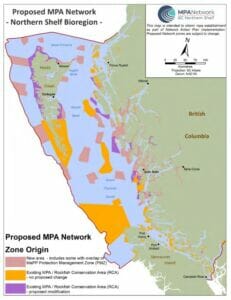Estimated Reading time

5 Mins
15 First Nations, Crown Governments Endorse Plan for Network of Protected Areas in the Great Bear Sea
At IMPAC5 marine conservation summit, First Nations and their partners shared and endorsed a plan for the creation and collaborative governance of a network of marine protected areas along the northern coast of British Columbia.

After more than a decade of work, First Nations and their partners shared their plan to establish a network of Marine Protected Areas (MPAs) along the northern coast of British Columbia. On Saturday, Feb. 4, leaders from 15 First Nations joined representatives from the Governments of Canada and British Columbia to announce their endorsement of the MPA Network Action Plan, which sets out a timeline and strategy for collaborative governance of protected areas in the Northern Shelf Bioregion, also called the Great Bear Sea.
The Action Plan – developed through close collaboration between First Nations, Crown governments, and environmental groups – identifies more than 30,000 square kilometers of new and existing protected areas in the Great Bear Sea. By linking these protected areas and managing them as a group, First Nations and their partners can protect sensitive ecosystems, preserve and connect marine habitat, and steward areas of cultural importance.
“We are honoured to showcase this Marine Protected Areas Network Action Plan—a milestone for ocean conservation that will protect and restore marine ecosystems across the North and Central Coast and Haida Gwaii,” said K̓áwáziɫ Marilyn Slett, Chief Councillor of the Heiltsuk Tribal Council and President of Coastal First Nations, in a joint press release. “Our shared commitment to collaborative governance and management, based on sound science and traditional knowledge, is an example of true reconciliation in action, and provides a blueprint for improving marine management and ocean stewardship worldwide.”
Our shared commitment to durable finance, and to the Great Bear Sea PFP, is core to a model that will deliver healthier seas while creating jobs, supporting economic development, and bringing people home to healthier communities.

The Northern Shelf Bioregion extends from the top of Vancouver Island to the Canada-Alaska border. These waters have sustained First Nations for more than 14,000 years and are home to an abundance of marine species – including salmon, whales, sea otters, shellfish, kelp, and ancient corals.
To develop the Action Plan, First Nations used Traditional Ecological Knowledge and modern science to identify sites and conservation objectives, and collaborated with the Government of Canada and the Province of British Columbia to engage communities and industries that depend on the ocean for resources, employment, and transportation.
With a plan in place, First Nations are working with their partners, including Coast Funds, to secure conservation financing to support management, stewardship, and sustainable economic activity in the Great Bear Sea. To enable sustainable long-term funding for this important work, First Nations have committed to developing a Project Finance for Permanence (PFP) initiative, modelled after the Great Bear Rainforest PFP and the creation of Coast Funds.
“Our shared commitment to durable finance, and to the Great Bear Sea PFP, is core to a model that will deliver healthier seas while creating jobs, supporting economic development, and bringing people home to healthier communities,” said Dallas Smith, President of Na̲nwak̲olas Council and Chair, Coast Funds’ board of directors, in the joint media release.
“Our Nations have a solid track record proving that Indigenous-led conservation works for nature and for people. Our Marine Protected Area network, together with our collaborative governance agreement, extends our vision for conservation and human well-being from the Great Bear Rainforest into the adjoining waters,” Smith said.
The last 15 years have proven that conservation finance works.
Just last week, Coast Funds released a report, Sustaining People and Place, sharing the story of the world’s first PFP (Coast Funds) and documenting the outcomes of nearly 15 years of First Nations’ investments in stewardship and economic development.
Through Coast Funds, First Nations in the Great Bear Rainforest and Haida Gwaii have leveraged an initial investment of $120 million and:
- Created 1,253 new, permanent jobs and invested $63.5 million in local salaries.
- Launched, acquired, and expanded 123 businesses, in sectors ranging from ecotourism to sustainable energy.
- Conducted 389 research and habitat restoration projects, benefitting 75 different species.
- Established 18 regional monitoring and Guardian Watchmen programs, which operate across more than seven million hectares of land and marine territory.
“The last 15 years have proven that conservation finance works,” said Eddy Adra, Coast Funds CEO. “First Nations have created family-supporting jobs and strengthened local economies, while protecting the lands and waters they’ve relied upon for millennia. Our team is excited to continue supporting First Nations as they prepare to extend ecosystem protections and conservation financing from land to sea.”
The endorsement of the Marine Protected Area Network Action Plan, announced at the IMPAC5 summit on marine conservation, comes just months after the Government of Canada’s $800-million commitment to four Indigenous-led PFPs, including one in the Great Bear Sea.
Links
Media Releases:
- Coastal First Nations and Na̲nwak̲olas Council:
Marine Protected Area Network Partners Endorse Plan to Protect BC’s North Coast - Fisheries and Oceans Canada:
First marine refuge within the Northern Shelf Bioregion is established
Further Reading:
